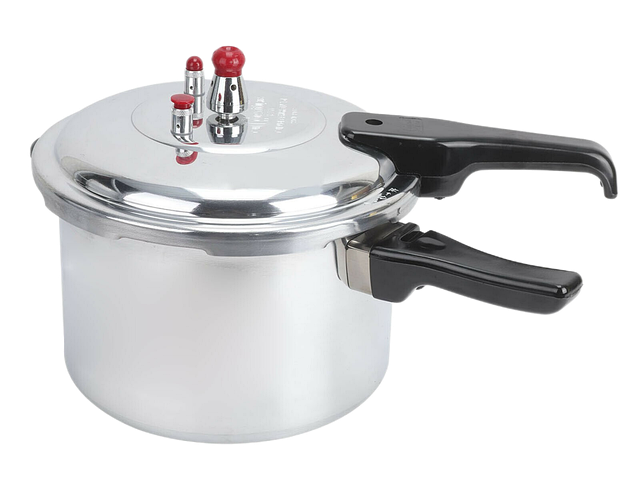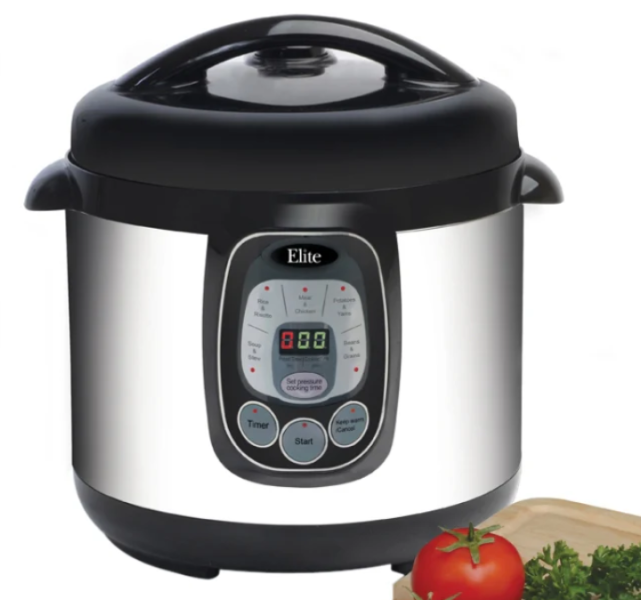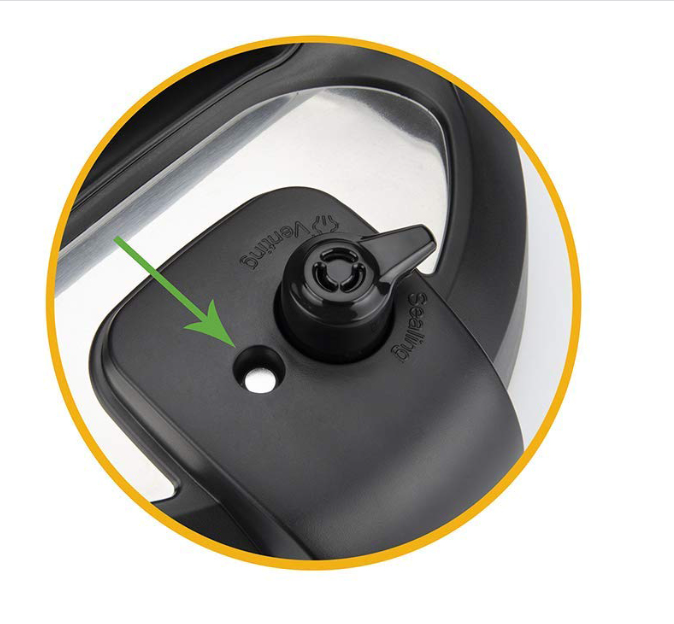Wondering how to use a pressure cooker for the first time? You’re in the right place. Whether you’re a seasoned cook or a beginner, we’ll show you how to get the most out of your new appliance. Keep reading to find out!

A Brief Introduction to a Pressure Cooker

Pressure cookers or pressure pots are a versatile tool for cooking delicious meals quickly and easily. This kind of cooking involves a cooking method that uses a sealed container to trap steam and build up pressure, which cooks food faster than traditional methods.
It’s a versatile and efficient way to prepare a wide variety of dishes.
Before you start cooking with your pressure cooker, it’s important to know the different parts and accessories that come with it.
To help first-time users, let’s break down the different parts of a pressure cooker and explain their functions in detail.
1. The Lid

The lid is a crucial component of the pressure cooker. It has a gasket or sealing ring, which ensures an airtight seal when the cooker is pressurized. It also has a pressure release valve, which lets you control the pressure level inside the cooker. This is usually a weighted valve that rocks or jiggles, or it can be a more modern spring-loaded valve.
The lid typically has a handle for easy handling.
2. The Pressure Pot or Cooking Vessel
The pot or cooking vessel is where you place the ingredients you want to cook. It’s usually made of stainless steel or aluminum. It should have measurement markings to help you add the right amount of liquid.
The pot usually has handles on the sides for easy transport.
3. Pressure Indicator

This is a small, often colored, indicator that rises when pressure builds inside the cooker. It helps you know when the cooker is pressurized, and it’s not safe to open the lid until this indicator drops back down.
4. Gasket or Sealing Ring

The gasket is a rubber or silicone ring that sits inside the lid to create an airtight seal. This is a vital safety feature, as it prevents steam from escaping and keeps the cooker pressurized.
5. Pressure Regulator
The pressure regulator is a device that helps control the pressure level inside the cooker. There are typically two types:
- Weighted Valve: This is a small, weighted valve that sits on top of the vent pipe. It rocks or jiggles when the pressure inside is at the right level.
- Spring-Loaded Valve: In more modern pressure cookers, there’s often a spring-loaded valve that rises to indicate pressure and releases steam as necessary to maintain the pressure.
6. Steam Vent/Cover Lock
The steam vent is a small hole that allows excess steam to escape when the cooker is building pressure. Once the cooker reaches the desired pressure, it’s sealed by a cover lock, ensuring the lid can’t be opened accidentally.
7. Handles and Controls
Pressure cookers usually come with handles on the pot and the lid for easy transport. They also have control features, such as a pressure setting knob, a timer, and heat settings.
Preparing To Use a Pressure Cooker for the First Time
Before you start cooking with your pressure cooker, it’s important to properly prepare it. This step is crucial to ensure that your meals come out fine and without any issues.
Here are some tips to follow if you’re preparing to use a pressure cooker for the first time:
1. Read the Manual
Start by thoroughly reading the user manual that comes with your pressure cooker. Manuals provide essential information on assembly, operation, and safety precautions.
2. Inspect Components
Before assembly, inspect all the components of the pressure cooker. Ensure that there are no visible damages, and all parts are included.
3. Clean Before Use
Wash all removable parts of the pressure cooker, such as the cooking pot, sealing ring, and steam rack, before the first use. This ensures cleanliness and removes any manufacturing residues.
4. Understand Safety Features
Familiarize yourself with the safety features of the pressure cooker, including pressure release valves, locking mechanisms, and steam release systems. Understanding these features is crucial for safe operation.
5. Assemble Lid Correctly

Pay close attention to the correct assembly of the lid. Ensure that the sealing ring is properly placed, and the pressure release valve is in its correct position. Follow the manufacturer’s guidelines for your specific model.
6. Check Gaskets and Seals
Inspect the gaskets and seals for any signs of damage or wear. These components are crucial for maintaining pressure, so they should be in good condition.
7. Attach Handles and Accessories
If your pressure cooker comes with detachable handles or other accessories, attach them according to the instructions. This is typically a straightforward process, but varies by brand and model.
8. Use the Right Amount of Liquid
Ensure that you add the correct amount of liquid as specified in the user manual. Having insufficient liquid can affect the pressure build-up, while excess liquid can cause overcooking.
9. Test the Pressure Release Valve
Before cooking, test the pressure release valve to make sure it moves freely. This ensures that pressure can be released properly during and after cooking.
10. Practice Assembly
If possible, practice assembling and disassembling the pressure cooker without any ingredients. This helps you become familiar with the process and reduces the chance of errors during actual cooking.
How To Use a Pressure Cooker for the First Time [Guide]
Now comes the exciting part – cooking with the pressure cooker! Here are some tips to help you use a pressure cooker for the first time:
1. Prepare Your Ingredients
Start by placing your ingredients inside the pot. You should also add a suitable amount of liquid, like water or broth, to create steam for cooking.
2. Secure the Lid
Place the lid on the pot and make sure it’s properly aligned. Then, lock the lid in place. This usually involves turning it until it clicks, or using a locking lever, depending on the model.
3. Set Pressure and Timer

If your pressure cooker has adjustable settings, select the desired pressure level and cooking time. This can vary depending on the recipe you’re following.
Most pressure cookers have a pressure control setting. Common pressure levels are high (for faster cooking) and low (for more delicate foods). Use the control button or dial to select the desired pressure level.
Next is to determine the appropriate cooking time for your recipe. Digital pressure cookers often have a timer function. Press the timer button and use the “+” and “-” buttons to set the cooking time. For stovetop pressure cookers, use an external timer.
4. Start Cooking
Once you’ve set the pressure and timer, start the cooking process. On digital models, this may involve pressing a “Start” button. For stovetop models, turn on the heat. As the pot heats up, the liquid inside turns into steam, and the pressure indicator will rise.
5. Observe the Pressure Build-Up
It takes some time for the pressure cooker to pressurize. During this phase, you might see steam escaping from the pressure release valve. Once fully pressurized, the cooking time begins.
As the pressure increases, the pressure regulator will come into play. It will either rock or rise to indicate that the desired pressure has been reached.
Once the pressure has built up, the timer starts counting down. Note that the food cooks under pressure, which speeds up the cooking process significantly.
6. Release Pressure
After the cooking time elapses, the pressure cooker will typically beep or indicate that it has finished. You can allow the pressure to release naturally for certain recipes or use the quick-release method as per your recipe’s instructions.
By Natural Release, I mean you just have to allow the pressure to drop naturally by turning off the heat source. This can take some time but is often used for delicate foods.
For Quick Release, you need to manually release the pressure using the pressure release valve. Be cautious as hot steam will escape. So, use an oven mitt or towel to avoid burns.

7. Serve Your Meal
Once the pressure is released, you can safely open the lid, and your delicious, well-cooked meal is ready to be served.
Pressure cookers are great for speeding up cooking times, making tougher cuts of meat tender, and infusing flavors. Just be sure to follow safety instructions and guidelines specific to your pressure cooker model to ensure safe and enjoyable cooking experiences.
You might also want to check out our guide on how to cook with an electric gas cooker.
Cleaning and Maintaining a Pressure Cooker After Use
Proper cleaning and maintenance of your pressure cooker is important to ensure it lasts a long time and works properly. Here are some tips to follow if you’re to clean a pressure pot after use for the first time:
- Wash the pot and all its parts separately after each use.
- Make sure to remove any food debris from the release and pressure valves.
- Check the gasket periodically for wear and replace it if needed.
Final Note
You now know how to use a pressure cooker for the first time. You’ve learned all the tips and tricks you need to know to become an expert pressure cooker chef. So what are you waiting for? Grab your ingredients and start cooking!
